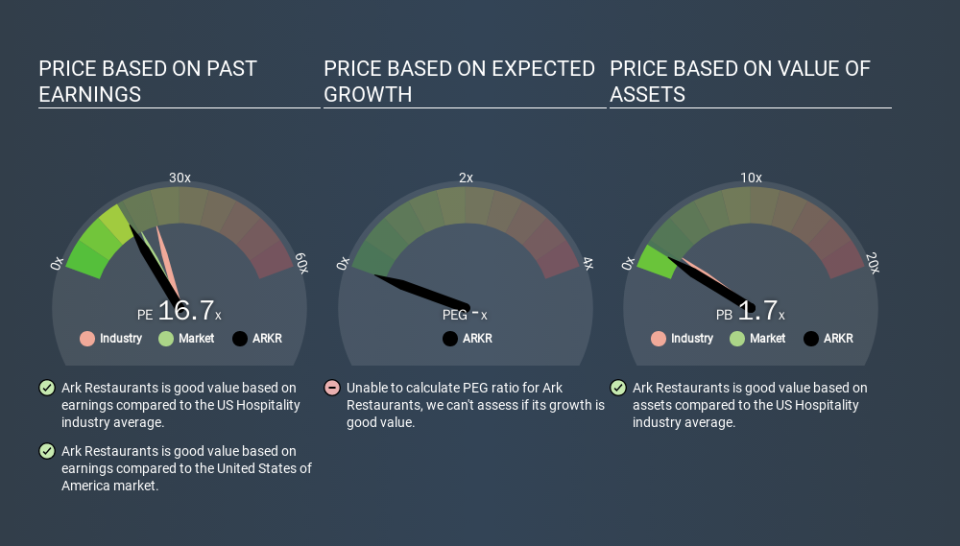Is Ark Restaurants Corp.'s (NASDAQ:ARKR) P/E Ratio Really That Good?

Unfortunately for some shareholders, the Ark Restaurants (NASDAQ:ARKR) share price has dived in the last thirty days. Even longer term holders have taken a real hit with the stock declining 2.4% in the last year. At least the stock is still up slightly on where it was at the start of the quarter.
All else being equal, a sharp share price increase should make a stock less attractive to potential investors. While the market sentiment towards a stock is very changeable, in the long run, the share price will tend to move in the same direction as earnings per share. So some would prefer to hold off buying when there is a lot of optimism towards a stock. Perhaps the simplest way to get a read on investors' expectations of a business is to look at its Price to Earnings Ratio (PE Ratio). Investors have optimistic expectations of companies with higher P/E ratios, compared to companies with lower P/E ratios.
View our latest analysis for Ark Restaurants
How Does Ark Restaurants's P/E Ratio Compare To Its Peers?
We can tell from its P/E ratio of 16.74 that sentiment around Ark Restaurants isn't particularly high. The image below shows that Ark Restaurants has a lower P/E than the average (23.3) P/E for companies in the hospitality industry.
Its relatively low P/E ratio indicates that Ark Restaurants shareholders think it will struggle to do as well as other companies in its industry classification. Many investors like to buy stocks when the market is pessimistic about their prospects. If you consider the stock interesting, further research is recommended. For example, I often monitor director buying and selling.
How Growth Rates Impact P/E Ratios
Companies that shrink earnings per share quickly will rapidly decrease the 'E' in the equation. Therefore, even if you pay a low multiple of earnings now, that multiple will become higher in the future. A higher P/E should indicate the stock is expensive relative to others -- and that may encourage shareholders to sell.
Ark Restaurants saw earnings per share decrease by 15% last year. And EPS is down 6.2% a year, over the last 3 years. This could justify a low P/E.
A Limitation: P/E Ratios Ignore Debt and Cash In The Bank
One drawback of using a P/E ratio is that it considers market capitalization, but not the balance sheet. So it won't reflect the advantage of cash, or disadvantage of debt. The exact same company would hypothetically deserve a higher P/E ratio if it had a strong balance sheet, than if it had a weak one with lots of debt, because a cashed up company can spend on growth.
Such expenditure might be good or bad, in the long term, but the point here is that the balance sheet is not reflected by this ratio.
How Does Ark Restaurants's Debt Impact Its P/E Ratio?
Net debt is 30% of Ark Restaurants's market cap. While that's enough to warrant consideration, it doesn't really concern us.
The Bottom Line On Ark Restaurants's P/E Ratio
Ark Restaurants has a P/E of 16.7. That's below the average in the US market, which is 18.6. Since it only carries a modest debt load, it's likely the low expectations implied by the P/E ratio arise from the lack of recent earnings growth. Given Ark Restaurants's P/E ratio has declined from 16.7 to 16.7 in the last month, we know for sure that the market is less confident about the business today, than it was back then. For those who don't like to trade against momentum, that could be a warning sign, but a contrarian investor might want to take a closer look.
Investors have an opportunity when market expectations about a stock are wrong. If the reality for a company is not as bad as the P/E ratio indicates, then the share price should increase as the market realizes this. Although we don't have analyst forecasts shareholders might want to examine this detailed historical graph of earnings, revenue and cash flow.
But note: Ark Restaurants may not be the best stock to buy. So take a peek at this free list of interesting companies with strong recent earnings growth (and a P/E ratio below 20).
If you spot an error that warrants correction, please contact the editor at editorial-team@simplywallst.com. This article by Simply Wall St is general in nature. It does not constitute a recommendation to buy or sell any stock, and does not take account of your objectives, or your financial situation. Simply Wall St has no position in the stocks mentioned.
We aim to bring you long-term focused research analysis driven by fundamental data. Note that our analysis may not factor in the latest price-sensitive company announcements or qualitative material. Thank you for reading.

 Yahoo Movies
Yahoo Movies 

